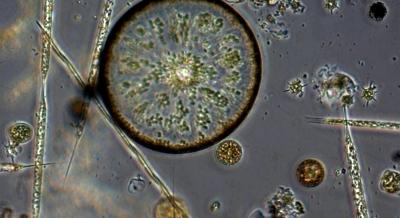Phytoplankton
Phytoplankton, also known as microalgae, are similar to terrestrial plants in that they contain chlorophyll and require sunlight in order to live and grow. Most phytoplankton are buoyant and float in the upper part of the ocean, where sunlight penetrates the water. Phytoplankton also require inorganic nutrients such as nitrates, phosphates, and sulfur which they convert into proteins, fats, and carbohydrates.
The two main classes of phytoplankton are dinoflagellates and diatoms. Dinoflagellates use a whip-like tail, or flagella, to move through the water and their bodies are covered with complex shells. Diatoms also have shells, but they are made of a different substance and their structure is rigid and made of interlocking parts. Diatoms do not rely on flagella to move through the water and instead rely on ocean currents to travel through the water.
In a balanced ecosystem, phytoplankton provide food for a wide range of sea creatures including shrimp, snails, and jellyfish. When too many nutrients are available, phytoplankton may grow out of control and form harmful algal blooms (HABs). These blooms can produce extremely toxic compounds that have harmful effects on fish, shellfish, mammals, birds, and even people.
Source: NOAA National Ocean Service
OVERVIEW
Tiny plankton play a mighty role in the health of Puget Sound
Diverse communities of microscopic organisms called phytoplankton make up the base of the aquatic food web. In that role, they are essential to the tiny animals that eat them, but phytoplankton are not dependent on others. Thanks to chlorophyl, these tiny organisms can generate their own energy from nutrients and sunlight. Despite their critical importance to a great diversity of sea life in Puget Sound, phytoplankton can also contribute to low-oxygen conditions, and some can be harmful in other ways.
RELATED ARTICLES
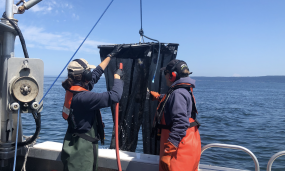
The ups and downs of zooplankton in Puget Sound
Zooplankton are critical to the marine food web, but until recently there have been few surveys of the zooplankton community in Puget Sound. Ongoing monitoring is now revealing a system full of complexity and surprises. The following article was commissioned by the Habitat Strategic Initiative Lead (HSIL), a cross-agency team co-led by the Washington Departments of Fish and Wildlife and Natural Resources.
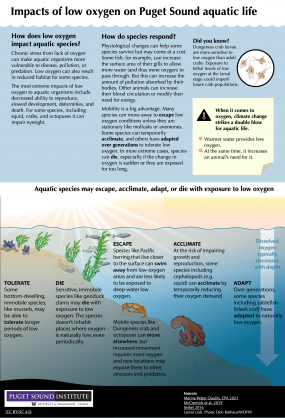
Impacts of low oxygen on Puget Sound aquatic life (infographic)
Chronic stress from lack of oxygen can make aquatic organisms more vulnerable to disease, pollution, or predation. Low oxygen can also result in reduced habitat for some species. Aquatic species may escape, acclimate, adapt, or die with exposure.
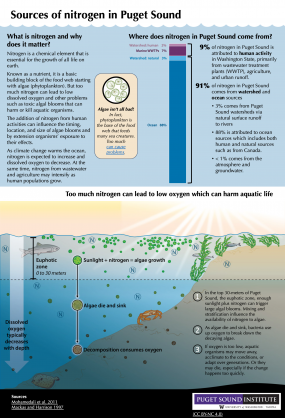
Sources of nitrogen in Puget Sound (infographic)
Nitrogen is a chemical element that is essential for the growth of all life on earth. But too much nitrogen can lead to low dissolved oxygen and other problems such as toxic algal blooms that can harm or kill aquatic organisms.

Hypoxia (fact sheet)
The following fact sheet provides an overview of low oxygen conditions in Puget Sound. It addresses some of the related causes and concerns that have been identified by scientists in the region. The overview was prepared in conjunction with a series of workshops on hypoxia and nutrient pollution presented by the University of Washington Puget Sound Institute.
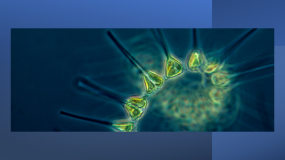
Phytoplankton and primary productivity (fact sheet)
In many parts of Puget Sound, hypoxic waters are thought to be at least in part due to overgrowth of microscopic algae, which is triggered by excess nitrogen. That means it’s important to understand the dynamics of primary productivity – the rate at which those microscopic algae, known as phytoplankton, produce organic matter through photosynthesis and in this way provide the base of the food web. Researchers are investigating different types of phytoplankton and rates of primary productivity throughout the Salish Sea, and seeking to understand how primary productivity is likely to change as climate change alters patterns of coastal upwelling and freshwater flow into the Sound.
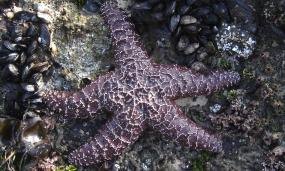
Oxygen for life: How low dissolved oxygen affects species in Puget Sound
Scientists are reporting a decline in oxygen-rich waters throughout the world. Causes for the decline vary from place to place but may involve climate change and increasing discharges of tainted water. In Puget Sound, low oxygen levels can occur naturally or due to eutrophication from human-caused pollution. In this five-part series, we describe the critical nature of oxygen to Puget Sound sea life. Scientists are finding that changes in oxygen levels can lead to physiological adjustments, shifts in predator-prey relationships and other repercussions throughout the food web.

